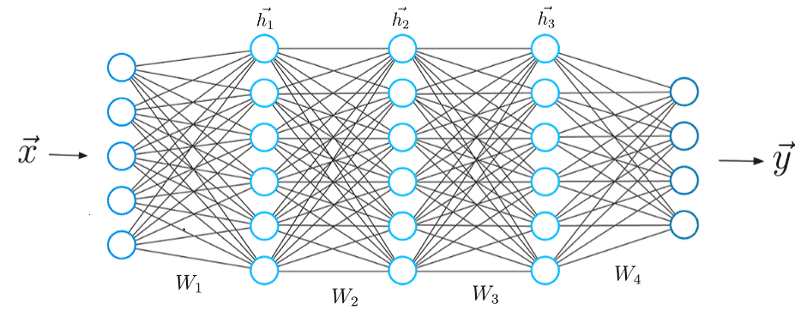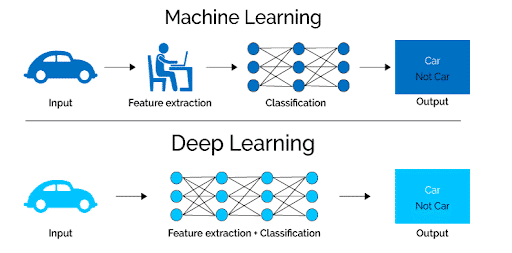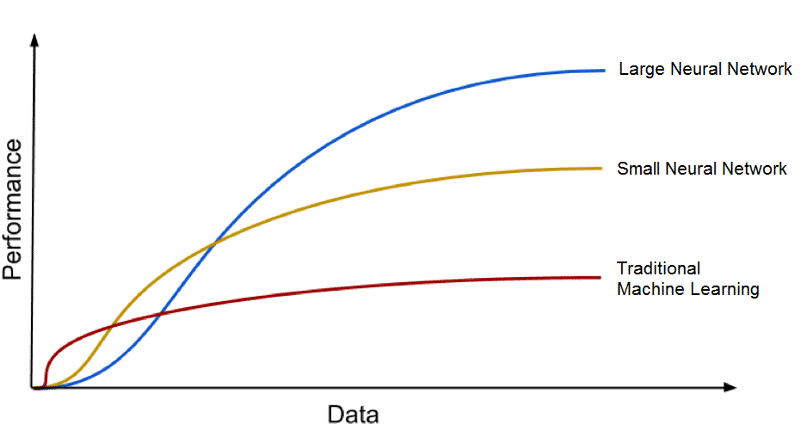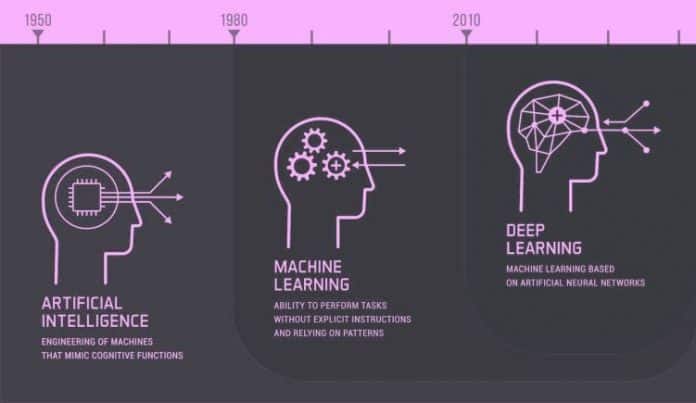Artificial Intelligence
AI is a term that describes the process by which a machine imitates cognitive functions humans share with each other, such as problem solving and learning. AI can also be described as a program that instructs the machine how to behave in particular situations. Artificial intelligence is essentially a series of if-else statements.
A simple rule that is programmed by a person is an if-else statement. Imagine a robot driving on a road. The robot might follow a programed rule like:
if something_is_in_the_way is True:
stop_moving()
else:
continue_moving()So, when we’re talking about artificial intelligence it’s more worthwhile to consider two more specific subfields of AI: machine learning and deep learning.
Machine Learning vs. Deep Learning
We now have a better understanding of what AI is, so we can look closer at machine learning and deeplearning to make a distinction between them.
AI VS. MACHINE LEARNING DEEP LEARNING
- Artificial Intelligence – A program that can sense and reason, act, and adapt.
- Machine Learning: Algorithms whose performance increases as they are exposed more data over time.
- Deep Learning is a subset of machine-learning in which multilayered neural network learn from large amounts of data.
MACHINE LEARNING IS NOT NEW TECHNOLOGY
What is machine learning? Machine learning can be described as a collection of algorithms that analyze data and learn from it, making informed decisions based upon those insights.
Machine learning can be used to automate a wide range of tasks. Machine learning is a common problem in almost every industry, from IT security malware searching, to weather forecasting, and stockbrokers looking to make optimal trades. Complex math and extensive coding are required to produce the desired functions and results in machine learning. Machine learning can also include classical algorithms for different types of tasks, such as classification, regression and clustering. These algorithms require large amounts of data to be trained. Your model will improve the more data you provide.
- When someone says they are working with a machine learning algorithm, you can get to the gist of its value by asking: what’s the objective function?
Machine learning is an old field. It uses algorithms and methods that have been around since the 1960s, some even back then. These algorithms are the Naive Bayes Classifier as well as the Support vector Machines. Both of these classic algorithms are used often in data classification. There are many cluster analysis algorithms, such as the K-Means or tree-based clustering. Machine learning employs methods like principal component analysis and the tSNE to reduce data dimensionality and provide more insight into data’s nature.
A machine learning model’s training component is a part that optimizes along a particular dimension. Machine learning models attempt to minimize errors between predictions and actual ground truth values.
This is where we need to define an error function, also known as a loss function or an objective function. Because the model has an end goal, it must be defined. This could be used to categorize data (e.g. This could be to predict the future price of a stock or cat and dog photos. If someone claims they’re using a machine-learning algorithm to analyze data, it is possible to get the essence of the value by asking the question: What’s the objective function?
Deep Learning: The Next Big Thing
Deep learning is not machine learning. It is a subfield of artificial intelligence that uses artificial neural networks.
Deep learning algorithms require data to solve problems and learn. We can call it a subfield in machine learning. Deep learning and machine learning are often used interchangeably. These systems can have different capabilities.
Deep learning is based on a multi-layered structure called the neural network.

Artificial neural networks are able to perform tasks that machine learning models cannot.
Deep learning is the key to all of our recent intelligence breakthroughs. Deep learning would have prevented the development of chatbots, self-driving cars and personal assistants such as Siri and Alexa. Google Translate would be primitive, and Netflix wouldn’t know which TV series or movies to suggest.
Deep learning and artificial neural networks are the driving forces behind the new industrial revolution. Deep learning offers two key advantages over machine learning, making this the closest and most accurate approach to machine intelligence.
WHY Is DEEP LEARNING MORE EFFECTIVE THAN MACHINE LEARNING?
No Feature Extract
Deep learning has the first advantage over machine learning in that feature extraction is redundant.
Deep learning was long before the advent of machine learning. Traditional machine learning methods such as logistic regression, SVM and Naive Bayes classifier, decision trees, SVM, and Naive Bayes classification were still very popular. These algorithms are also known as flat algorithms. Flat algorithms are not able to be applied directly on raw data such as text, images,.csv and so forth. We need to perform feature extraction, a preprocessing step.
We provide an abstract representation (or feature extraction) of the data that can be used by classic machine learning algorithms to complete a task. The classification of the data into different classes or categories. Feature extraction can be very complex and requires a deep understanding of the problem domain. For optimal results, this step should be modified, tested, and refined over multiple iterations. Features are not required to extract deep learning models.
Artificial neural networks are a great option for deep learning models. They don’t need feature extraction. The layers can learn an implicit representation from the raw data by themselves.
Deep learning models produce an abstract representation of the raw data that is compressed over many layers of an artificial neural networks. To produce the result, we use a compressed representation to extract the input data. The result could be, for instance, the classification of input data into different classes.
The neural network optimizes the step during the training process to get the best abstract representation of the input data. The feature extraction process is automated and performed by deep learning models that require minimal manual effort. In other words: feature extraction is part of the artificial neural network process without any human input.
To use machine learning models to determine if an image depicts a car, humans must first identify its unique features (size, shape, windows, wheels, etc.). These features can be extracted and given to the algorithm as input data. The machine learning algorithm would then classify the image. This means that in machine learning, the programmer must directly intervene in the classification process.

The Era of Big Data
Deep learning’s other advantage, and the key to understanding why it is so popular, lies in its ability to use massive amounts of data. Big data technology will open up a world of possibilities for deep learning innovations.

Deep learning models are more accurate when there is more training data. Traditional machine learning models like SVM or Naive Bayes classifier, however, stop improving after reaching a saturation point.
A larger number of data will make deep learning models more efficient. Andrew Ng (chief scientist at China’s largest search engine Baidu), co-founder of Coursera and leader of the Google Brain Project, said that data is the fuel for a deep learning algorithm.
Benefit from Massive discount on our 5G Training with 5WorldPro.com
Start your 5G journey and obtain 5G certification
contact us: contact@5GWorldPro.com


